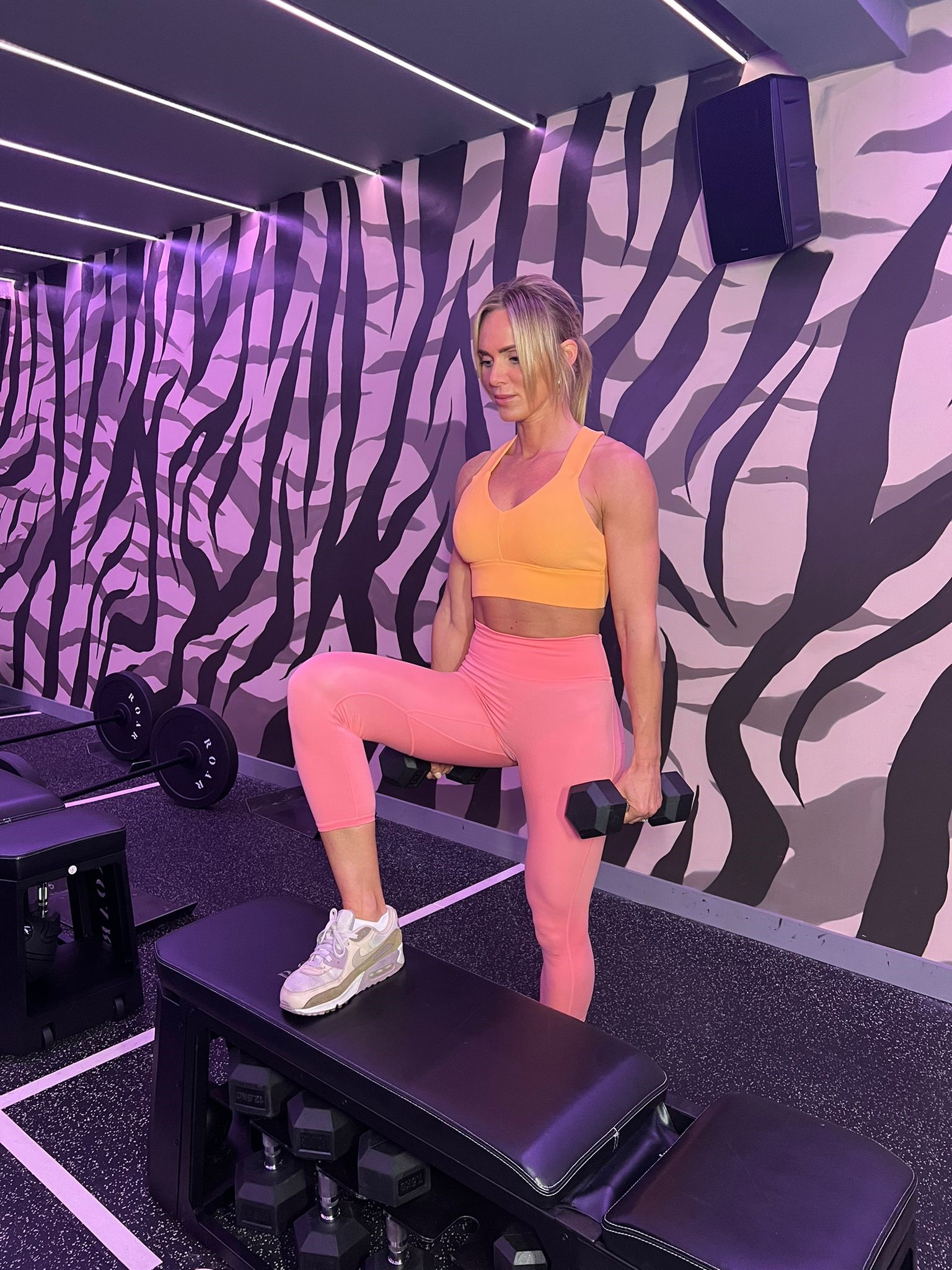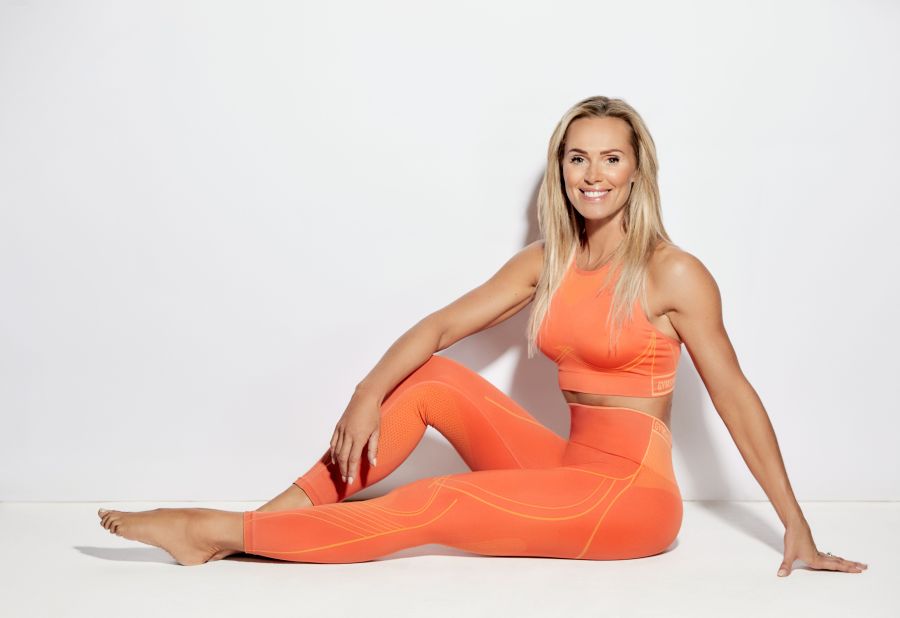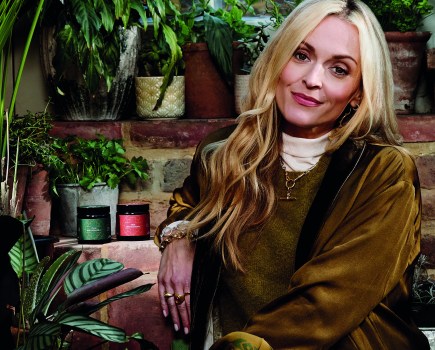Britain’s body transformation queen and PT to the stars, Sarah Lindsay reveals how to build gym courage and her secret to sculpting a strong physique…
Sarah Lindsay’s Roar Fitness gym in London’s Kensington has a gallery of pictures on the reception wall that prove exactly why the triple Olympian-turned-PT is being hailed the ‘UK’s Queen of transformations’. Jaw-dropping before and afters could motivate even the most languid gym-goer to grab a pair of dumbbells in pursuit of peak power.
Just ask Piers Morgan, one of the latest stars to recruit Sarah, who, since retiring from professional speed skating 12 years ago, has opened a trio of London gyms (with another set to open in Dubai later this year) where weight lifting – as opposed to cardio – is the ticket to top-to-toe body sculpting.
Sarah, who was the British women’s short-track speed skating champion for 10 consecutive years, qualified as a PT before retiring in 2010, and is now the PT of choice for celebrities, including Vogue Williams, Paloma Faith and Nick Grimshaw. She is also carving a global fanbase. During lockdown, her regular Insta Live workouts were so fitness-inspiring, she went on to launch a dedicated online platform of full-body metabolic classes.
Weight training over cardio
Explaining the benefits of metabolism-boosting weight training over cardiovascular exercise, Sarah, 41, says: ‘Unlike cardio, weight training is smarter and more efficient, so it’s great if you’re time-starved. We’re now being told to reach 20,000 steps a day – that’s three hours of walking daily. Who has the time for that? I don’t!’
She adds: ‘If you’ve got some extra weight on you, the best thing to do is to start weight training because being heavier will make you stronger, and if you’re stronger, you can stimulate the muscle more. Lots of people think, “I’ll lose weight, then I’ll go sculpt”. No! Start weight training, sort out your diet by cutting out junk and sticking to more natural foods, then your body fat will come down and you’ll quickly start to build a physique.’
And, according to Sarah, anyone is able achieve a dream body transformation by mastering just “six-to-eight basic weight-lifting moves” and sticking to a nutrient-dense, planned and monitored food plan. Ready to learn more? Here, Sarah talks about life after professional sport, how she suffered from a post-retirement identity crisis and why being authentic in fitness helps her stand out from the crowd.
When did you realise you had a passion for exercise?
‘From the age of five, I did loads of different sports – gymnastics, athletics, horse rising, swimming – then, from the age of seven, figure skating. One day at the rink, someone talent spotted me and asked me to speed skate. It turned out I was better at speed skating than figure skating because I was more athletic and competitive than I was girlie and into dancing. I’d race speed skaters wearing my figure skates because my parents couldn’t afford speed skates. After six months of begging and trying really hard at practice, they finally got me a pair of second-hand long track skates. The day I put them on, the coach at my club said: “You’re a speed skater now”. It was the best feeling.’
Who was your first fitness inspiration?
‘My mum, Jude, who’s just 20 years older than me, was always mega fit and high energy. When I was seven or eight, she would get me up at 5am to go running so she had a running friend. When I was about 16, mum took me to the gym. She was wearing a crop top and tiny shorts and everybody was looking at her, all the men and all the women. She had abs and muscular arms. I remember thinking she was badass.’
What was your biggest speed skating achievement?
‘On paper, I was European gold medallist, World silver medallist, 10 times British champion and three times Olympian, but even after all those achievements, I was disappointed because I thought I could have done better. I was really critical of myself and, looking back, I wish I’d enjoyed those glory moments more and been better at patting myself on the back.
‘As an athlete I was like a machine. I had to be a robot. I had 20 minutes between races so I couldn’t be crying about the last race or I wouldn’t win the next. So, I became very good at boxing feelings away but I now realise that, as well as blocking pain and sadness, I didn’t feel happiness and joy in the same way. I’m still not particularly emotional but I now let myself feel. I’m far more empathetic and caring, and I always want to make sure everyone around me is happy and looked after. If I can impact someone’s day in a positive way, I will.’
Describe the transition from professional athlete to PT.
‘As an athlete, I was on edge every day because I wanted to perform and didn’t want to hurt myself. It was scary going fast on the ice, so I was pumped with adrenaline and cortisol. When that was gone, I felt very under-stimulated physically and, for a year after retiring, I felt very down. Maybe I’d been physically addicted to that feeling, maybe it was a hormonal response to not exercising so intensely… but whatever the reason, it was a tough time.
‘There was also an impact on my identity. I was proud to be an Olympic athlete, then all of a sudden I was a personal trainer and I wasn’t proud of that because I didn’t truly understand how important a PT role could be. My confidence built by learning the trade and doing the best job I could. After 12 months of high-volume hours I became a much better coach, but my training is ongoing. I’m lucky to be in a position to make people feel good. Not everyone has job satisfaction or can have a positive impact on people.’

Sarah Lindsay: ‘I was proud to be an Olympic athlete, then all of a sudden I was a personal trainer and I wasn’t proud of that because I didn’t truly understand how important a PT role could be.’ (Image: @RoarFitnessGirl)
How did your training change after retirement?
‘As a professional speed skater, I trained six-to-nine hours a day, six days a week, so I was exhausted all the time. I did a lot of endurance work on the ice and spent hours on the exercise bike, which I’d never do now. After my skating career ended, I started only weight training for an hour each day. I wanted to get strong and to train my upper body – I’d never been allowed to as an athlete because of the extra weight. I weighed 57kg at my last Olympics in 2010 and then, in less than three months, I got to just under 68kg.
‘For most people, gaining 11kg of muscle would be impossible but, because I was used to training so much, recovery from an hour of weights a day was easy, so I grew really fast. Nowadays, I do three one-hour weight training sessions a week and make sure I’m active every day. Most days I’ll go for a walk, which is my meditation time.
What do you love most about weight training?
‘Being strong gives me lots of confidence and is always going to be beneficial. No-one has ever come into Roar and said: “I want to be weaker”!’
Have you faced objection to being a woman with muscles?
‘I’m less muscular than I used to be, but 10 years ago most people would come into the gym and say: “I don’t want to get too muscular”, while looking at my arms. So I started wearing jumpers during consultations!
‘The London 2012 Olympics changed a lot of people’s attitude to female strength. People were watching amazing female athletes and seeing their bodies on the track in all their glory. I noticed women coming into our gym wanting to be stronger and more athletic, rather than skinny. It sparked a real shift. I don’t get any objections now!’
What is the key to feeling gym confident?
‘Gyms can be intimidating spaces because you always feel like someone else is better than you – and they probably are! The key is to know six-to-eight basic weight-lifting moves, understanding how your body moves and doing them right. Once you start building strength and progressing, confidence grows.
‘Programmes don’t have to be complicated or convoluted. Simply look at what the body does – you push, you pull, you flex at the hips, you squat and you overhead press. Get strong at those basic moves, then you can get more detailed [moves] once you start to build a physique. Then, if you want better shoulders, add in more shoulder exercises and when you start to plateau, vary the moves.’
Top weight-training rule?
‘Never compromise on form. When you get too tired to lift with good form, stop. If you keep lifting with bad form, you’ll incur injury. Even if you’re brilliant and super strong, if you can’t maintain form, that’s when the reps are finished. Muscle a weight up badly and you end up using every other muscle.’
Are you strict with your diet?
‘Other than dairy, which I’m allergic to, there are no enemy foods, but I try to eat organic and natural foods, not only to ensure I have the energy reserves for training but also to maintain good health. Your muscles, skin and organ tissue are made up from the food and nutrients that you ingest, so quality is paramount. I’m always thinking about health, longevity and how the food I eat will help me recover.’
Does being an Olympian give you an advantage as a PT?
‘If you copy people you’ll never be unique, stand out or be as good as you can be – you’ll just be a worse version of someone else. I don’t compete with anyone. I just do the best I can. I’m always thinking about making Roar better, how I can improve the service. I’m always trying to move forwards!’
Head to roar-fitness.com for details of live workouts, studio classes and how to subscribe to the Roar At Home platform.
Stay tuned for an exclusive strength-training workout from Sarah Lindsay, coming soon!
Words: Gemma Calvert | Lead image: Dan Kennedy | Additional imagery: @RoarFitnessGirl








